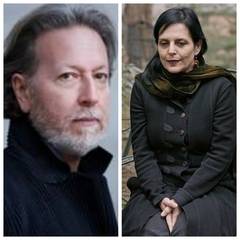|
Back
Lubman Leads Sounds and Silence New York
Wu Tsai Theater, David Geffen Hall, Lincoln Center
10/29/2025 -
Chaya Czernowin: Unforeseen Dusk: bones into wings
Hans Abrahamsen: Vers le silence
NeueVocalSoloisten, Students of Juilliard Orchestra, New York Philharmonic Orchestra, Brad Lubman (Conductor)

B. Lubman/C. Czernowin (© Peter Serling/Wikipedia Commons)
“”The whole feeling of our existence now is very much a dusk. The horizon is shadowed and does not bode well. Yet... this can still move and create an opening for fragility that is connected to hope.”
Chaya Czernowin
The names of esteemed conductors immediately summon up measures of the works where they are associated. This is difficult with Brad Lubman. Yes, he knows the “standards”, the “top 20s”. But his genius is giving contemporary music a clarity, a control, and an emotional relationship to any audience.
And this was true last night, a single performance of two radically different New York premieres.
Chaya Czernowin, born in Haifa but living in the United States, has been widely acclaimed and for good reason. Her work is wide‑ranging, but much of it comes from her adoration of Japanese butoh, dance theater which is abstract, where bodies “unravel” to reveal inner tensions, inner transformations, Thus her enigmatic quasi-metaphysical title Unforseen Dusk: bones into wings.
The result was a wordless series of cries and whispers and vociferations, incredibly lovely soprano melismata up to (what seemed to be) a few notes higher than high C. The six soloists were from Germany’s “Vocalsolisten” and their fame for “finding new forms are vocal expression” was well deserved.
But where butoh in Japan has a breathless yet percussive quality, Ms. Czermowin was working with the New York Philharmonic, and the results were different.
I can only describe it anecdotally. The geography of shamanism extends from Korea through Japan to Siberia and westward to north Finland. I first heard the chanting of a shaman on a remote seaside village in Korea’s Cheju island one midnight, and the effect was traumatizing.
The woman’s pure soprano voice went up and down the scale, quietly, solemnly, and if the moon had a voice that night, it would be hers.
More important, she was standing by the sea. And I knew instinctively that her voice and the ebony sky could only be accompanied by the gentle waves.
Ms. Czermowin magically was able to fill in the nautical blanks, to show through an orchestra what the waves would have spoken. (What was Mahler’s movement name? “What the Meadow Flowers Tell Me”).
The 30 minutes floated like air. Breaths, tappings, rolls of snare drums, soft brass consorts... The astonishing thing is that Ms. Czermowin had no constructs, no structure that I could find.
The seemingly aleatoric vocal and orchestral lines (its shifts from note to note, seemingly unpredictable) had the illusion of inevitably springing from the measure before. Yet the orchestral sounds, vocal harmonies (they did sound somehow like Mussorgsky hidden under masses of instruments) added to the aura of rhythmless dance, colors erupting and floating from a Verne‑like supernatural earth and stars together. Not with grief, not with terror, but with orchestral/vocal curiosity about something beyond words–or notes–in ourselves.

H. Abrahamsen (© Lars Skaaning)
In Ms. Czermowin, all was unexpected yet somehow revealing. Hans Abrahamsen’s Vers le Silence was the opposite. Like a Shakespeare prologue, where the whole plot is given away from the beginning, Mr. Abrahamsen gave the game away The Danish composer has offered some haunting music previously (much with his obsession with snow). In Vers le silence (Toward Silence), his words hinted at the elements–fire, water etc–yet three of his four movements had their own architecture.
They began blazing! This is no understatement. The New York Philharmonic was augmented by no less than 45 Juilliard students. How else could they replicate an orchestration with quartets of winds and brass, 20 percussion, and a massive string consort.
How did that coincide with the eponymous “towards the silence”. Each movement began with carefully conceived blasting, but within minutes (each section was about seven minutes long), the music evaporated to a long pppp. Sometimes with tubular bells and marimba, sometimes with a few violins. And the last minutes came a fourth movement of unalloyed magnificent funereal music. At times it sounded like Eroica‘s funeral, at times like Purcell’s grieving sinfonias.
With Mr. Abrahamsen’s allusions, from elemental fire to a close liturgical silence, Maestro Lubman controlled both orchestras with the precision, energy and silence that the work deserved.
Harry Rolnick
|